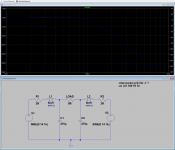I think I remember, from back in the days before powered subs, that there was a way to connect a single passive sub to a standard stereo amplifier that was also driving the main speakers. There may have been some other misc capacitors or something involved, but it was an extremely simple thing, that worked to combine both L+R signals for the subwoofer, but keeping L and R separate to each of the main speakers.
I can’t seem to remember, or to find, that method anywhere. Of course there’d be very little application for it today, except in the mind of some old 60+ experimenter who has this thing that he wants to connect to that thing, and can’t remember how to do it.
Assume that this thing will have a simple lowpass filter... any ideas?
I can’t seem to remember, or to find, that method anywhere. Of course there’d be very little application for it today, except in the mind of some old 60+ experimenter who has this thing that he wants to connect to that thing, and can’t remember how to do it.
Assume that this thing will have a simple lowpass filter... any ideas?
K9gardner,
Unless the single sub has a dual voice coil, there is no safe way to connect it to both sides of a standard stereo amplifier that also drives the main speakers.
Most music tracks tend to have mono bass below around 100 Hz, so connecting a single sub with appropriate passive crossover (usually coil and capacitor) to a single side of a stereo amp that can support the lower impedance along with one main speaker works OK.
That said, if you are 60+, your collection will probably include "stereo" tracks of the Beatles (and others) with bass panned hard right or left- stereo subs are a good idea for that music.
Art
Unless the single sub has a dual voice coil, there is no safe way to connect it to both sides of a standard stereo amplifier that also drives the main speakers.
Most music tracks tend to have mono bass below around 100 Hz, so connecting a single sub with appropriate passive crossover (usually coil and capacitor) to a single side of a stereo amp that can support the lower impedance along with one main speaker works OK.
That said, if you are 60+, your collection will probably include "stereo" tracks of the Beatles (and others) with bass panned hard right or left- stereo subs are a good idea for that music.
Art
Theoretically you can with measures, the 8Ω load between + + channel outputs appearing bridged acting like 4Ω per side. Hugely inefficient to filter passively as it will also take 4Ω source impedance per side not to severely peak the bass response at one frequency and also avoid amp overload. Damping factor consequently goes south to only 1 and there is as much dissipation in the sum sources impedance as in the woofer itself.
Takes two low pass networks one for each side (channel) with the parasitic R in coils plus series high power resistors equaling 4Ω per side. The woofer's sensitivity must also be 3dB/W higher than the main speakers. Dual voice coil woofers avoid the bridge method and extra summation resistances / losses. Even then the high mH value passive crossover coils are still costly and the total filter inflexible.
Much better is to use an affordable Class D plate module driving the woofer with facilities of low pass filter control, gain control, phase control, and channels summing. Like the SD100 from Parts Express.
Takes two low pass networks one for each side (channel) with the parasitic R in coils plus series high power resistors equaling 4Ω per side. The woofer's sensitivity must also be 3dB/W higher than the main speakers. Dual voice coil woofers avoid the bridge method and extra summation resistances / losses. Even then the high mH value passive crossover coils are still costly and the total filter inflexible.
Much better is to use an affordable Class D plate module driving the woofer with facilities of low pass filter control, gain control, phase control, and channels summing. Like the SD100 from Parts Express.
Attachments
Budget and preference for plate amp models aside, L-Pad signal dividers can be included in RCA barrels to convert high level speaker output signals to line level when there is no extra preamp output. Two 1/4W resistors fit. 1kΩ series to 100Ω parallel for instance can divide by ten times or 20dB.
You guys are great, I think you immensely for the info. Regarding using dual subs, it’s just that I already have this one box that I want to try to make use of with a couple of compact speakers in the other room. I’m not looking to buy another sub. But I’ve been looking at the plate amps on Parts Express anyway, it sounds like that’s probably the best way for me to go. Not sure which one yet. But thanks again for all of the input. It helps a lot. If I actually do this, I’ll let you know how it comes out.
Well, take your time but not too much because today is my 71 year old birthday!

Holy smokes, you don’t look a day over
Happy birthday, and to think we learned it here. All the best to you, and many more.
I actually started to post a response last night but... the server logged me out while I was polishing and refining my post so as not to waste everyone’s time. Actually I had finished the post. When I hit submit, it told me I wasn’t logged in, and when I had to log in again, all was lost. It was a bit upsetting.
To avoid doing the same thing again, please allow me to post this part, so I get the birthday greeting in, and then I’ll come back and tell you what I did. I feel kinda dumb, so of course I have to tell you.
Let me try to do a short version of what I tried to post last night. First, it’s amazing what you can learn when you actually look at the speaker you’re talking about, instead of doing it from year-old memory of a found object. So it turns out: it is a dual voice coil woofer. That makes that part of it easier. The more embarrassing part of what I didn’t remember is that even though it’s a passive woofer, it has outputs for the speakers. Aha! It has a crossover. Yes, I opened it up to confirm. I didn’t attempt to capture the component ratings at all but did some listening tests with a tone generator. It seems that the crossover is high, maybe 100-110 Hz, which leaves a noticeable hole in the mid-bass.
I’m just running the whole thing off a pretty crappy class D mini-amp right now. I may take the suggestion to use a 2.1 plate amp with variable crossover frequency to power my small “satellites” (which are really the passive sides of two non-functioning Audioengine A2s) more satisfactorily. The woofer does provide a nicer foundation, with less effort, than I had expected, so that’s a good thing.
Thanks again to everyone for your thoughtful support and suggestions. Even if I do feel like I led us on a bit of a wild goose chase, I still learned something.
I’m just running the whole thing off a pretty crappy class D mini-amp right now. I may take the suggestion to use a 2.1 plate amp with variable crossover frequency to power my small “satellites” (which are really the passive sides of two non-functioning Audioengine A2s) more satisfactorily. The woofer does provide a nicer foundation, with less effort, than I had expected, so that’s a good thing.
Thanks again to everyone for your thoughtful support and suggestions. Even if I do feel like I led us on a bit of a wild goose chase, I still learned something.
Thank you for your wishes, and I am glad that even in a small way, we have helped you.
Don't worry, I think the server disconnection is normal in this and other sites, because you can't spend much time occupying it while we write.
It is best to write in World Pad or some similar program, and copy and paste.
But I admit that I am not doing it because I think my contribution is going to be short, then it becomes long, and I always make the same mistake again.
The best for you and your affections !
Don't worry, I think the server disconnection is normal in this and other sites, because you can't spend much time occupying it while we write.
It is best to write in World Pad or some similar program, and copy and paste.
But I admit that I am not doing it because I think my contribution is going to be short, then it becomes long, and I always make the same mistake again.
The best for you and your affections !
- Home
- Loudspeakers
- Subwoofers
- Connecting a single passive sub to stereo amp


